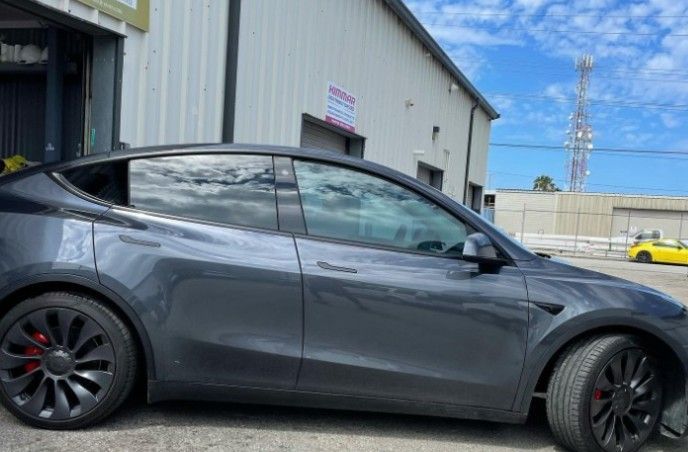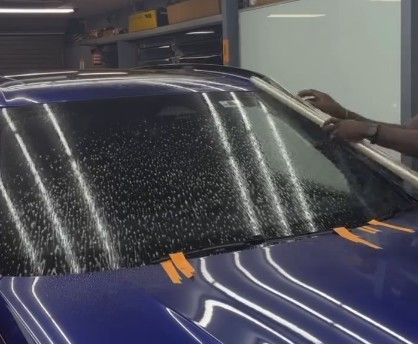Why Salt Air Makes Professional Ceramic Coating Essential for Island Vehicles
GET A QUOTEThe Cayman Islands offer residents and visitors a stunning coastal landscape, but the same saltwater that makes the beaches beautiful can be a significant threat to your vehicle. The salty air found in coastal regions like the Cayman Islands can wreak havoc on your car's paint and metal components, leading to corrosion, fading, and other forms of damage over time. For island car owners, this environmental challenge requires a serious solution, one that traditional car care methods, such as wax, simply can't address.
In this blog, we’ll explain how salt air affects your vehicle, why it's essential to protect your car with professional ceramic coating, and why this service is a necessity, not a luxury, for vehicles living on the islands.

The Cayman Islands are known for their tropical climate, with high humidity, intense sunlight, and coastal winds. These conditions are ideal for beach-goers and tourists, but they also pose significant challenges for vehicle owners. The constant exposure to salty air from the sea accelerates the degradation of your car's exterior. Over time, saltwater particles in the air accumulate on your vehicle, eating away at the paint and metal surfaces, and even leading to rust formation.
How Salt Air Impacts Vehicles Living Near the Coast
The presence of salt in the air, combined with humidity and moisture, creates a corrosive environment that damages the body and paint of vehicles. Salt is highly reactive, and when it comes into contact with your car's surface, it can lead to oxidation, rust, and pitting. This salt exposure is particularly harmful for vehicles that are parked near the coast or frequently driven near salty water. Without adequate protection, your vehicle will begin to show signs of wear, including fading paint, rust spots, and diminished aesthetic appeal.
Importance of Ceramic Coating for Vehicle Protection
One of the most effective ways to protect your vehicle from the damaging effects of salt air is by investing in professional ceramic coating. Unlike traditional wax, ceramic coating offers long-lasting protection, creating a strong, hydrophobic layer that shields your vehicle’s exterior from salt, water, dirt, and contaminants. It’s no longer just a luxury; for island vehicles in the Cayman Islands, ceramic coating is a necessity to preserve your car's appearance and value.
The Science Behind Salt Air: How It Damages Your Vehicle's Exterior
Salt air from the ocean may seem harmless, but it has a profound impact on the health of your vehicle. Understanding how salt interacts with your car’s paint and metal is crucial to appreciating the value of professional ceramic coating.
The Chemical Composition of Salt in the Air and Its Corrosive Properties
Salt, specifically sodium chloride (NaCl), is highly hygroscopic, meaning it attracts moisture from the air. When salt particles in the air come into contact with your car’s surface, they form a layer of moisture that can sit on the paint, slowly corroding it over time. This reaction is especially severe in coastal areas where humidity levels are high, causing the salt to persist and continue its damaging effects.
How Salt Air Accelerates Oxidation and Rust Formation on Vehicle Surfaces
Oxidation is the process by which metal reacts with oxygen and moisture, resulting in rust formation. Salt air accelerates oxidation by introducing salt particles that act as catalysts in this chemical reaction. When salt comes into contact with the metal components of your car, such as the undercarriage, wheel wells, and body panels, it facilitates the formation of rust, which can lead to severe structural damage. This process is significantly faster in coastal environments like the Cayman Islands, where the salt content in the air is higher.
The Impact of Salty Moisture on Car Paint and Body Components
Salty moisture doesn't just affect the metal parts of your vehicle; it also impacts the paint. Over time, the salt causes the paint to degrade, leading to discoloration, fading, and the loss of the vehicle's glossy finish. As the salt penetrates the paint, it can also contribute to the formation of unsightly water spots and stains. These elements not only diminish the appearance of your car but can also compromise the integrity of the paint job, requiring costly repairs or repainting.
Why Traditional Car Wax Isn’t Enough to Protect Vehicles from Salt Air
Car wax has been a traditional go-to solution for adding a layer of protection to vehicle paint for many years. However, when it comes to vehicles exposed to the harsh coastal conditions of the Cayman Islands, traditional car wax simply doesn’t provide the level of long-term protection needed. While wax may offer some initial benefits, it falls short when it comes to standing up to salt air, humidity, and other environmental factors typical of island living. Let’s explore why traditional wax is not enough to safeguard your vehicle and why a more advanced solution, such as ceramic coating, is essential.

How Traditional Waxes Perform in Coastal Conditions
Traditional waxes are primarily designed to create a protective barrier on top of your car’s paint. They provide a glossy finish and some degree of water resistance. The wax works by filling in tiny imperfections in the paint, offering a smooth surface that makes it easier for water to bead up and roll off. However, the protection provided by wax is temporary and relatively weak compared to other alternatives.
- Temporary Barrier: Wax can provide a shiny, smooth finish, but it is not a long-term solution for protection. Over time, environmental elements such as rain, UV rays, and wind will break down the wax.
- Soft Layer: Since traditional wax forms a soft layer on top of the paint, it is more susceptible to damage from contaminants like dirt, bird droppings, tree sap, and road salts. In coastal areas like the Cayman Islands, the constant exposure to salty air accelerates the breakdown of this soft layer.
- Frequent Maintenance Required: Wax requires regular reapplication to maintain its protective qualities, especially in coastal conditions. If you live in the Cayman Islands, where salt air is ever-present, you will need to apply wax frequently to ensure your vehicle stays protected. This constant upkeep can be both time-consuming and costly over time.
Limitations of Wax in Preventing Saltwater Corrosion and Rusting
One of the major drawbacks of traditional wax when it comes to vehicles in coastal environments is its inability to provide adequate protection against saltwater corrosion and rusting. Salt in the air is highly corrosive and can cause damage to the paint and metal components of your vehicle. Here’s how wax falls short in preventing saltwater damage:
- Inability to Block Salt Particles: Salt particles in the air can easily penetrate the soft wax layer, allowing direct contact between the salt and the vehicle’s paint. This exposure leads to oxidation and rust formation, particularly on metal parts like the undercarriage, wheel wells, and exhaust system.
- Faster Breakdown in Coastal Conditions: Salt in the air accelerates the degradation of wax. In coastal areas like the Cayman Islands, the combination of salt air, humidity, and moisture creates a harsh environment that quickly breaks down the wax, leaving your vehicle exposed to the elements. The wax loses its effectiveness after just a few weeks or months, especially if your car is frequently exposed to coastal conditions.
- Limited Protection Against Rust: Wax does provide some level of resistance to water spots and UV rays, but it is not designed to stop the formation of rust. Saltwater is particularly problematic because it can rapidly speed up rusting when it comes into contact with metal surfaces. Wax will not stop this process, especially in the humid, salty air of island environments.
Why Professional Ceramic Coating is the Superior Alternative for Coastal Vehicles
Given the limitations of traditional wax, professional ceramic coating offers a much more effective and long-lasting solution for vehicles in coastal environments. Here are the key advantages of ceramic coating over wax:
- Long-Term Protection: Ceramic coatings bond chemically to the vehicle’s paint, creating a much stronger and more durable protective layer. This layer is resistant to salt, dirt, and other contaminants, and it lasts for months or even years, unlike wax, which requires frequent reapplication.
- Corrosion and Rust Prevention: Ceramic coatings provide a protective shield that prevents saltwater from making direct contact with the paint and metal components of your vehicle. This significantly reduces the risk of oxidation, rust, and corrosion, offering superior protection against the elements found in coastal climates.
- Hydrophobic Surface: The hydrophobic properties of ceramic coatings ensure that water, dirt, and contaminants bead up and roll off the vehicle’s surface, making it easier to clean and preventing water spots and stains from forming. This helps to keep your vehicle looking clean and new for longer periods.
- Reduced Maintenance: Once applied, ceramic coatings require minimal upkeep. Unlike wax, which needs to be reapplied regularly, ceramic coatings provide long-term protection with little maintenance. This saves you time and money in the long run, especially in the harsh conditions of the Cayman Islands.
While traditional wax may offer temporary protection and a glossy finish, it is not sufficient to protect your vehicle from the harsh effects of salt air, rust, and corrosion in coastal environments like the Cayman Islands. Wax’s soft layer breaks down quickly, requiring frequent reapplication and offering limited defense against the elements. For vehicles exposed to salt air, ceramic coating is the superior choice. It offers long-lasting protection, corrosion resistance, and easier maintenance, making it the ideal solution for island car owners looking to preserve the appearance and longevity of their vehicles.
For the best protection, consider investing in professional ceramic coating for your vehicle. Reach out to Cayman Window Tinting today to learn more about how ceramic coatings can safeguard your vehicle from the damaging effects of salt air and ensure your car remains in pristine condition for years to come.
Why Professional Ceramic Coating is the Superior Alternative for Coastal Vehicles
Ceramic coating is the superior alternative to wax because it offers more durable and long-lasting protection. The coating forms a chemical bond with your car's paint, creating a strong, hydrophobic layer that repels water, dirt, and salt particles. Unlike wax, which can wear off after a few washes, ceramic coatings last for months or even years, providing consistent protection against corrosion, rust, and environmental contaminants. Ceramic coatings are specifically designed to resist the damaging effects of salt air, making them an essential investment for vehicles in coastal areas like the Cayman Islands.
Salt air is a constant threat to vehicles living in the Cayman Islands, and without proper protection, your car’s paint, body, and metal components are at risk of damage. Traditional wax simply isn’t enough to guard against the harsh effects of salt, humidity, and UV rays. Professional ceramic coating, however, offers the long-term protection and durability your island vehicle needs.
By investing in ceramic coating for coastal vehicles, you’ll be safeguarding your car against the corrosive effects of salt air, reducing the need for constant maintenance, and preserving its appearance and value. For the best protection in the Cayman Islands, trust Cayman Window Tinting for your professional ceramic coating needs. Contact us today to learn more about how we can help protect your vehicle from the damaging effects of salt air.

The Role of Ceramic Coating in Preventing Rust and Paint Damage
When it comes to coastal living, especially in areas like the Cayman Islands, saltwater and humidity can wreak havoc on your vehicle’s exterior. Over time, the salty air can penetrate the vehicle’s paint layers, leading to corrosion, fading, and other forms of damage. Ceramic coatings provide an essential layer of protection, preventing saltwater from penetrating your vehicle’s surface and ensuring long-lasting defense against rust and paint degradation. Let’s explore how ceramic coatings play a critical role in protecting your car from these harmful elements.
1. Preventing the Penetration of Saltwater into Vehicle Paint Layers
Saltwater is highly corrosive and can quickly break down the protective layers of your vehicle's paint. Traditional methods like waxing create a temporary shield, but this is not enough to withstand the constant exposure to salt in coastal areas. Ceramic coatings, however, create a chemical bond with the paint that forms a durable, long-lasting barrier.
- Hydrophobic Effect: Ceramic coatings have hydrophobic properties that cause water and salt to bead up and roll off, preventing them from sticking to the paint. This reduces the chances of saltwater soaking into the paint, which can lead to oxidation and corrosion.
- Preventing Salt Penetration: The molecular bond of the ceramic coating creates an impermeable layer on your vehicle’s surface. This layer is far more effective at preventing saltwater from reaching the paint than traditional wax, which simply sits on top of the surface and is easily washed away.
2. How Ceramic Coatings Act as a Barrier Between Salt Air and the Vehicle Surface
The primary role of ceramic coatings is to act as a barrier between your vehicle’s surface and harmful contaminants, including salt air. Salt particles in the air can attach to the surface of your vehicle, and over time, they can corrode both the paint and metal components of your car. By providing a strong, bonded protective layer, ceramic coatings ensure that salt air does not make direct contact with the paint or metal.
- Chemical Bonding: Ceramic coatings bond at the molecular level with your vehicle’s surface, forming a strong, durable layer of protection. This is unlike wax, which simply covers the surface and can wear away quickly.
- Long-Lasting Protection: Ceramic coatings provide lasting protection against salt air, offering a shield that can last up to two years or more, reducing the need for frequent reapplications like traditional waxing.
3. The Difference Between Surface-Level Protection and Deep, Long-Lasting Defense
Traditional wax or sealants primarily offer surface-level protection, creating a thin, temporary layer that can be easily compromised by rain, salt, or dirt. Ceramic coatings, on the other hand, provide a deep, long-lasting defense that integrates with the vehicle's paint. This integration ensures that the protective layer remains intact for a much longer period, even when exposed to harsh environmental conditions.
- Surface-Level Protection: Wax forms a thin, superficial layer that is prone to wear and tear. In coastal environments, this layer deteriorates rapidly, exposing the paint to contaminants.
- Deep, Long-Lasting Defense: Ceramic coatings provide a much stronger, molecular-level bond with the paint. This ensures that the vehicle remains protected even in extreme weather conditions, offering a longer lifespan of protection and less maintenance.
How Salt Air Affects Specific Parts of Your Vehicle
Salt air does more than just damage the paint on your car’s exterior; it affects various components of your vehicle, from the trim and chrome to the undercarriage and wheel wells. Understanding how salt air impacts these specific areas will help highlight why ceramic coatings are so critical in coastal environments.
Salt air has a particularly harmful effect on the exterior surfaces of your vehicle. It can cause paint to fade, oxidize, and lose its shine. It also accelerates rust formation on metal components such as chrome and trim.
- Paint: The exposure to salt air causes the paint to degrade over time, leading to discoloration and fading. Without proper protection, the salt particles can eat away at the paint, leaving unsightly marks and damage.
- Chrome and Trim: Chrome and trim pieces are particularly vulnerable to salt air, as salt accelerates corrosion. Without proper protection, these components can start to rust and lose their shine, leading to an unattractive appearance and possible long-term damage.
The Undercarriage and Wheel Wells: Areas Most Vulnerable to Corrosion
The undercarriage and wheel wells are the areas most susceptible to saltwater damage. These parts of the vehicle are constantly exposed to road salts, water, and dirt, which can lead to rapid corrosion if not properly protected.
- Undercarriage: The undercarriage is often overlooked, but it is one of the first areas to suffer from salt exposure. Without ceramic coating, the metal parts underneath the vehicle can quickly rust, leading to costly repairs.
- Wheel Wells: The wheel wells also experience constant exposure to salt and dirt from the road. Without proper protection, saltwater can seep into these areas, causing rust and damage to the metal components of your vehicle.
How Ceramic Coatings Provide Full Coverage for All Parts of Your Vehicle
Unlike wax, which primarily protects the paint and surface, ceramic coatings offer comprehensive coverage for your entire vehicle. The protective layer extends to areas that are often neglected, such as the undercarriage, wheel wells, chrome, and trim, ensuring full protection against the corrosive effects of salt air.
- Full Vehicle Protection: Ceramic coatings cover not just the paint but also other vulnerable areas, offering a comprehensive defense against saltwater, rust, and environmental contaminants.
- Durable Coverage: The bond created by ceramic coatings ensures that all parts of your vehicle are protected for an extended period, even in the toughest coastal conditions. This provides peace of mind for vehicle owners who want to ensure their car stays in top condition.
Salt air is one of the most significant threats to vehicles in coastal environments like the Cayman Islands. It can cause corrosion, rust, and paint damage, especially in areas like the undercarriage and trim. Traditional methods like waxing only offer surface-level protection and require frequent reapplication, making them less effective in these harsh conditions. Ceramic coatings provide a strong, durable, and long-lasting solution. By acting as a barrier between salt air and your vehicle, ceramic coatings protect the paint and metal components from the damaging effects of saltwater. They also offer full coverage for all parts of your vehicle, ensuring comprehensive protection that traditional wax simply cannot match.
Investing in a ceramic coating for coastal vehicles is not just a luxury; it’s a necessity for those living in coastal regions. For the best protection against salt air and the harsh environmental conditions of the Cayman Islands, consider professional ceramic coating services from Cayman Window Tinting. Contact us today to schedule your consultation and give your vehicle the protection it deserves.
Why Choose Cayman Window Tinting for Your Ceramic Coating Needs
When it comes to protecting your vehicle from the harsh coastal conditions of the Cayman Islands, Cayman Window Tinting is your trusted local expert for professional ceramic coating services. Our team understands the unique challenges that salt air, humidity, and UV exposure present to vehicles living in coastal environments. We use only high-quality ceramic coatings that provide durable, long-lasting protection to keep your car looking pristine and maintain its value. Our expert technicians have years of experience applying ceramic coatings and offer customized solutions to ensure your vehicle receives the best possible protection. At Cayman Window Tinting, we pride ourselves on delivering meticulous service with the highest attention to detail. We not only help preserve the exterior of your vehicle but also make it easier to maintain with a smooth, hydrophobic surface that repels dirt and water.
By choosing us, you are investing in your car’s future. Whether you want to protect the paint, prevent rust, or enhance your vehicle’s overall appearance, our ceramic coating services are designed to provide comprehensive protection against the salt and elements that can damage your car in coastal areas.
Conclusion
In conclusion, ceramic coating for coastal vehicles is essential for those living in the Cayman Islands. The harsh salt air, UV rays, and humidity can cause serious damage to your vehicle’s paint and metal components. While traditional wax may offer some temporary protection, it simply isn’t enough to stand up to the elements in a coastal environment. Ceramic coatings offer a superior solution by creating a strong, long-lasting barrier that protects your car from saltwater, rust, and fading.
When you choose Cayman Window Tinting for your ceramic coating needs, you're making the smart choice to protect your vehicle. With our professional application and high-quality products, you can rest assured that your car will remain in top condition for years to come. Don’t wait for corrosion and damage to take their toll. Contact us today to schedule your ceramic coating consultation and give your car the protection it deserves.




